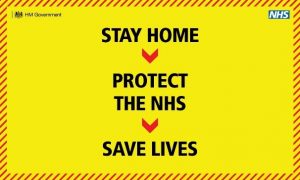The importance of solid messaging and storytelling
During the COVID-19 pandemic, being able to deliver on communications goals has been a matter of life and death.
In a morbid way, the pandemic has been a communicator’s dream. When else do you get to compare and contrast the comms strategies of every public and private sector organisation at the same time?
It’s changed PR forever and has forced organizations to take a good hard look at their comms processes. It’s also reaffirmed a lot of the PR staples practitioners were already familiar with, but sometimes struggle to get organizations to appreciate. Two particular areas have stood out: messaging and narrative development.
Messaging

I’m U.K. based and have been fascinated by our government’s comms. The initial message was well-received (relatively speaking) because it demanded a binary behavior change (i.e. stay in vs go out) and explained the benefit of compliance: “Stay home > Protect the NHS > Save lives.”
The follow up message was not as well received: “Stay alert > Control the virus > Save lives.” This also explained the benefit of compliance, but was ridiculed and hijacked. Worse than that, the other countries in the U.K. refused to endorse it, with Scotland’s First Minister Nicola Sturgeon demanding associated advertising not be shown to the Scottish people (ultimately Sturgeon opted for a very similar message, with the timing of its publication being the main differentiator). Government ministers were then guilty of confusing the public in subsequent national broadcast appearances with contrasting detail on what people should or shouldn’t do.
Messaging takeaways
1. Keep it simple stupid. Yes, your company might sell whizz-bobs to multiple stakeholders and you may be “niche” with 17 USPs, but at the end of the day media outlets want easily explainable descriptions and key messages that their readers will understand.
2. Repetition is a winner when it comes to messaging recall. Boris Johnson’s team opted for a three-part message, in a two-word, three-word, two-word structure. They then repeated this rhythm in the second statement. They also used “instruction” > “objective”> “outcome’” for both messages. The most obvious difference was the stop/go red/green colour scheme. These messages are PR works of art and will surely be staples of communication study in future.

3. Brief, brief and then brief some more. The reason Sturgeon and the other governments around the UK didn’t get on board with the second message was because they weren’t prepared. They claim they hadn’t been briefed before being blindsided by the new messaging.
And the reason the majority of the British public felt the government’s message on the next steps of easing out of lockdown was not clear, was because government spokespeople weren’t all singing from the same hymn sheet. They were being challenged on detail live on air and they didn’t have the answers. If your spokesperson doesn’t know the answer to a question relating to an unfolding crisis, then they should be trained to admit that, before stating they’ll establish the facts and feedback.
Once you’ve finalized your messaging, make sure everyone within your organization is briefed on the rationale behind it and its objective. Even if they don’t agree with it, it should help reduce negative reactions from employees who feel they’ve been caught unawares.
Narrative development
The PR process is naturally a rapid one, but the pandemic has further increased the speed at which news is progressing. Companies with something relevant to say this morning are irrelevant by this afternoon. Spending a couple of days chasing one of your spokespeople for a time to chat to a journalist, isn’t going to cut it.
At a recent event, WPP founder Sir Martin Sorrell said that in his view, “…internal communications teams are a barrier to the speed of organizational response”. Naturally, internal comms teams have a job to do, but at the moment their job should be getting the right spokespeople to commit to agile responses before connecting them with media relations specialists, who in turn will try and remove themselves from the spokesperson/journalist equation as far as possible.
Narrative takeaways: Daily sessions to ascertain your senior leadership’s thoughts on the latest news are preferable. If you can get a ten-minute call booked in with your CEO every morning in which you brief each other (they react to the news and you give them the media’s take) you’ll be well-prepared to then spend an hour dropping your contacts a line with the latest thoughts from your organization. They could be as simple as a paragraph in an email sent to key contacts in which your spokesperson expresses their opinion on what’s going on—but don’t just repeat what’s already been said. Add to the story, or stay silent until you can.
Optimize the speed of our organisational response and prepare your spokespeople. Don’t be proud and insist on being involved. You need to stay briefed, but the closer you can get your spokespeople to the media, the better.
And that media training you’ve been putting off? Invest in it now. Get the trainer to ask awkward questions. Put your spokespeople in front of a camera.
Listen to a few broadcast interviews with similar spokespeople and you’ll soon pick up the pattern of questioning. Almost everyone’s being asked the same stuff: How are you protecting employees? Will you make redundancies? How are you keeping the public safe? If you’re global, then what’s your approach to other regions where the pandemic is in a different phase? Yes, your organisation will get a plug and you’ll hopefully be able to relay some key messages, but don’t expect an easy ride.
The pandemic hasn’t changed PR, but it has emphasized how important it is to get the fundamentals right. Consistent messaging, thorough briefings and narrative progression will position your organisation as a trusted, valuable source.
Use the pandemic as an opportunity to hammer home PR best practice – be consistent, keep it simple and move the story on.
Luke Budka is head of digital PR and SEO at B2B growth agency TopLine Comms.
Looking for more insights on brand storytelling and content marketing? Join us for PR Daily’s Brand Storytelling & Content Marketing Virtual Conference (Aug. 4-5).






